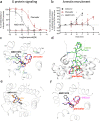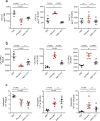Biased action of the CXCR4-targeting drug plerixafor is essential for its superior hematopoietic stem cell mobilization
- PMID: 33980979
- PMCID: PMC8115334
- DOI: 10.1038/s42003-021-02070-9
Biased action of the CXCR4-targeting drug plerixafor is essential for its superior hematopoietic stem cell mobilization
Abstract
Following the FDA-approval of the hematopoietic stem cell (HSC) mobilizer plerixafor, orally available and potent CXCR4 antagonists were pursued. One such proposition was AMD11070, which was orally active and had superior antagonism in vitro; however, it did not appear as effective for HSC mobilization in vivo. Here we show that while AMD11070 acts as a full antagonist, plerixafor acts biased by stimulating β-arrestin recruitment while fully antagonizing G protein. Consequently, while AMD11070 prevents the constitutive receptor internalization, plerixafor allows it and thereby decreases receptor expression. These findings are confirmed by the successful transfer of both ligands' binding sites and action to the related CXCR3 receptor. In vivo, plerixafor exhibits superior HSC mobilization associated with a dramatic reversal of the CXCL12 gradient across the bone marrow endothelium, which is not seen for AMD11070. We propose that the biased action of plerixafor is central for its superior therapeutic effect in HSC mobilization.
Conflict of interest statement
The authors declare no competing interest.
Figures





Similar articles
-
GPC-100, a novel CXCR4 antagonist, improves in vivo hematopoietic cell mobilization when combined with propranolol.PLoS One. 2023 Oct 25;18(10):e0287863. doi: 10.1371/journal.pone.0287863. eCollection 2023. PLoS One. 2023. PMID: 37878624 Free PMC article.
-
Recent advances on the use of the CXCR4 antagonist plerixafor (AMD3100, Mozobil™) and potential of other CXCR4 antagonists as stem cell mobilizers.Pharmacol Ther. 2010 Dec;128(3):509-18. doi: 10.1016/j.pharmthera.2010.08.009. Epub 2010 Sep 15. Pharmacol Ther. 2010. PMID: 20826182 Review.
-
PIM1 inhibition effectively enhances plerixafor-induced HSC mobilization by counteracting CXCR4 upregulation and blocking CXCL12 secretion.Leukemia. 2019 May;33(5):1296-1301. doi: 10.1038/s41375-019-0428-6. Epub 2019 Feb 28. Leukemia. 2019. PMID: 30816332 No abstract available.
-
Plerixafor: A chemokine receptor-4 antagonist for mobilization of hematopoietic stem cells for transplantation after high-dose chemotherapy for non-Hodgkin's lymphoma or multiple myeloma.Clin Ther. 2010 May;32(5):821-43. doi: 10.1016/j.clinthera.2010.05.007. Clin Ther. 2010. PMID: 20685493 Review.
-
A novel CXCR4 antagonist for hematopoietic stem cell mobilization.Expert Opin Investig Drugs. 2008 Nov;17(11):1749-60. doi: 10.1517/13543784.17.11.1749. Expert Opin Investig Drugs. 2008. PMID: 18922110 Review.
Cited by
-
CXC Chemokine Ligand 12 Facilitates Gi Protein Binding to CXC Chemokine Receptor 4 by Stabilizing Packing of the Proline-Isoleucine-Phenylalanine Motif: Insights from Automated Path Searching.J Am Chem Soc. 2025 Mar 26;147(12):10129-10138. doi: 10.1021/jacs.4c14293. Epub 2025 Mar 17. J Am Chem Soc. 2025. PMID: 40096846 Free PMC article.
-
GPC-100, a novel CXCR4 antagonist, improves in vivo hematopoietic cell mobilization when combined with propranolol.PLoS One. 2023 Oct 25;18(10):e0287863. doi: 10.1371/journal.pone.0287863. eCollection 2023. PLoS One. 2023. PMID: 37878624 Free PMC article.
-
Predictive factors for peripheral blood stem cell mobilization in multiple myeloma in the era of novel therapies: A single-center experience.Cancer Med. 2024 Jun;13(11):e7356. doi: 10.1002/cam4.7356. Cancer Med. 2024. PMID: 38850125 Free PMC article.
-
Development of tolerance to chemokine receptor antagonists: current paradigms and the need for further investigation.Front Immunol. 2023 Jul 28;14:1184014. doi: 10.3389/fimmu.2023.1184014. eCollection 2023. Front Immunol. 2023. PMID: 37575219 Free PMC article. Review.
-
GPCR drug discovery: new agents, targets and indications.Nat Rev Drug Discov. 2025 Jun;24(6):458-479. doi: 10.1038/s41573-025-01139-y. Epub 2025 Mar 3. Nat Rev Drug Discov. 2025. PMID: 40033110 Review.
References
-
- Kenakin, T. The Application of Signaling Bias to New Therapeutic Drug Therapy for Seven Transmembrane (G Protein-coupled) Receptors: Quantifying Bias in Biased Signaling in Physiology, Pharmacology and Therapeutics (ed. Arey, J. B.) 81–102 (Elsevier, 2014).
-
- Murphy PM, et al. International union of pharmacology. XXII. Nomencl. Chemokine Recept. Pharmacol. Rev. 2000;52:145–176. - PubMed
Publication types
MeSH terms
Substances
Grants and funding
LinkOut - more resources
Full Text Sources
Other Literature Sources

